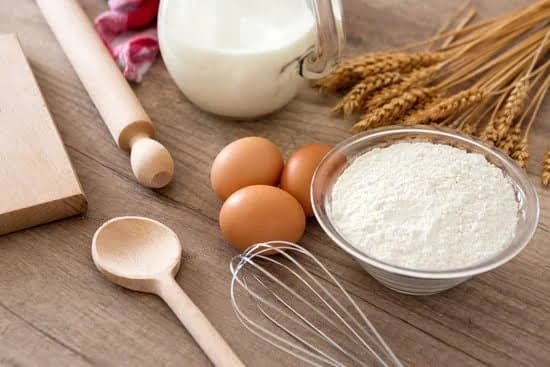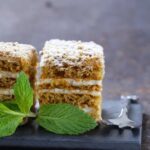A non-stick rolling pin is an essential tool in the world of cake decorating. It is specifically designed to make the rolling process smooth and prevent sticking of fondant or dough. This article will delve into the definition and explanation of a non-stick rolling pin, as well as explore its importance and benefits in cake decorating.
In cake decorating, achieving a flawless finish on your cakes is crucial, and a non-stick rolling pin plays a vital role in this process. Unlike traditional wooden rolling pins, which can cause sticking and tearing of delicate fondant or dough, a non-stick rolling pin ensures a seamless application without any mishaps.
The benefits of using a non-stick rolling pin go beyond just avoiding stickiness. They also provide even pressure distribution, allowing for consistent thickness throughout the cake surface. This feature makes it easier to create smooth surfaces for layering or sculpting intricate designs. Additionally, non-stick rolling pins are generally easier to clean compared to their traditional counterparts.
Understanding the purpose and advantages of using a non-stick rolling pin in cake decorating is essential for both beginners and experienced decorators alike. So let’s dive into this fascinating tool that can elevate your cake decoration skills to new heights.
Understanding the Purpose of a Rolling Pin in Cake Decorating
A rolling pin is an essential tool in cake decorating as it plays a crucial role in achieving even and smooth surfaces on cakes. Whether you are working with fondant or dough, a rolling pin helps to flatten and shape the medium to your desired thickness. Understanding the purpose of a rolling pin in cake decorating is key to mastering the art of creating flawless designs.
The primary function of a rolling pin is to apply pressure evenly across the surface of the cake medium, whether it be fondant or dough. By doing so, it allows for consistent thickness throughout, ensuring that your cake decorations are uniform and visually appealing. A rolling pin also helps to smooth out any bumps or uneven areas on the surface, providing a clean canvas for your creativity.
To achieve the best results with a rolling pin in cake decorating, it is important to choose the right type of rolling pin for your specific needs. There are various types of rolling pins available in the market, including traditional wooden rolling pins and non-stick rolling pins. Wooden rolling pins have been used for decades and offer durability and familiarity. However, non-stick rolling pins have gained popularity among cake decorators due to their unique advantages.
Non-stick rolling pins are specifically designed with a coating that prevents sticking of fondant or dough during the rolling process. This makes it easier to handle delicate mediums without worrying about tearing or damaging them.
Non-stick rolling pins also require less flour or powdered sugar dusting compared to wooden ones, which can alter the taste and texture of your final product. Additionally, some non-stick rolling pins come with ergonomic handles that provide better control and comfort while working on intricate cake designs.
Exploring Different Types of Rolling Pins
When it comes to cake decorating, having the right tools is crucial. One essential tool that every baker should have in their arsenal is a rolling pin. A rolling pin helps achieve even and smooth cake surfaces, making it easier to work with fondant and create intricate designs. In this section, we will explore the different types of rolling pins available in the market and compare traditional wooden rolling pins with non-stick rolling pins.
Traditional Wooden Rolling Pins
Traditional wooden rolling pins are a classic choice for many bakers. They are typically made from hardwood such as maple or beech and provide a sturdy and durable option for cake decorating. Wooden rolling pins come in various sizes and shapes, including straight, tapered, or French style. They offer a natural feel and weight that some bakers prefer.
However, one drawback of traditional wooden rolling pins is the potential for sticking. When working with sticky dough or fondant, these rolling pins may require excessive flour or powdered sugar to prevent sticking, which can affect the final result of the cake decoration.
Non-Stick Rolling Pins
Non-stick rolling pins have gained popularity among cake decorators due to their convenience and ease of use. These rolling pins are typically made from materials such as silicone or plastic, which have a non-stick surface. The non-stick coating allows for smooth rolling without the need for excessive flour or powdered sugar.
One advantage of non-stick rolling pins is their versatility. They can be used for various tasks in addition to cake decorating, such as pastry-making or cookie dough preparation. Non-stick rolling pins are also lightweight compared to traditional wooden ones, which may make them more comfortable to handle during lengthy decorating sessions.
Moreover, non-stick rolling pins often feature additional design elements that aid in cake decoration. Some models come with ergonomic handles that provide a firm grip and prevent slippage during use. Others may have embossed patterns on the rolling pin surface, allowing for easy imprinting of decorative designs onto fondant or dough.
Overall, while traditional wooden rolling pins have their merits, non-stick rolling pins offer a convenient and efficient solution for cake decorators. Their non-stick surface, versatility, and additional features make them a valuable tool in achieving flawless cake decorating results. In the next section, we will delve into the features and characteristics of non-stick rolling pins in more detail.
Features and Characteristics of Non-Stick Rolling Pins
Non-stick rolling pins are specifically designed tools that offer several features and characteristics that make them ideal for cake decorating. The design and composition of non-stick rolling pins play a crucial role in ensuring smooth and seamless cake surfaces.
One of the main features of non-stick rolling pins is their surface material, which is usually made from food-grade silicone or plastic. This material is non-porous and prevents the dough or fondant from sticking to the surface, making it easier to roll out without any tearing or stretching. The smooth texture of the non-stick surface also helps achieve an even thickness throughout the rolled-out dough.
In addition to the non-stick surface, non-stick rolling pins often have ergonomic handles that provide a comfortable grip and greater control while handling. These handles are designed with the user’s comfort in mind, reducing fatigue during long decorating sessions. Some non-stick rolling pins also come with embossed patterns on their surfaces, which can be handy when creating textured designs on cakes or adding intricate details.
The composition of non-stick rolling pins makes them not only easy to use but also easy to clean. Unlike traditional wooden rolling pins, which can absorb moisture and retain odors from ingredients used in baking, non-stick rolling pins can be easily washed with warm water and mild soap. This makes them more hygienic and ensures that no unwanted flavors or smells are transferred to future baking projects.
Overall, the features and characteristics of non-stick rolling pins make them invaluable tools for cake decorators. Their smooth, non-porous surfaces prevent sticking and tearing of fondant or dough, while their ergonomic handles provide comfort and control. Additionally, their ease of cleaning makes them a convenient choice for both professional bakers and home enthusiasts alike who want to achieve flawless cake designs.
Benefits of Using a Non-Stick Rolling Pin in Cake Decorating
A non-stick rolling pin offers a range of benefits to cake decorators, making it an essential tool for achieving professional-looking cake designs. One of the main advantages of using a non-stick rolling pin is that it prevents sticking and tearing of fondant or dough. This is particularly important when working with delicate decorations or intricate patterns, as it allows for smooth and flawless application.
Using a non-stick rolling pin also allows for greater precision and control in creating detailed cake designs. The smooth surface of the pin ensures that the fondant or dough maintains its shape and texture without distortion. This makes it easier to roll out the material evenly, resulting in consistent thickness throughout the rolled-out portion.
Another benefit of using a non-stick rolling pin is its ease of cleaning and maintenance. Unlike traditional wooden pins, which can absorb oils and flavors from the dough, a non-stick rolling pin can be quickly rinsed off under water or wiped clean with a damp cloth. Some non-stick rolling pins are even dishwasher-safe, making them convenient to use and maintain.
In addition to these advantages, non-stick rolling pins often come with additional features that further enhance their functionality. Many models have ergonomic handles that provide a comfortable grip, making them easier to maneuver while decorating cakes. Some non-stick pins also feature embossed patterns on their surfaces, allowing users to create textured designs directly onto the rolled-out fondant or dough.
Overall, incorporating a non-stick rolling pin into your cake decorating toolkit can greatly improve your efficiency and results. Its ability to prevent sticking and tearing ensures flawless application of fondant or dough, while its easy maintenance and additional features make it a convenient choice for both amateur and professional cake decorators.
| Benefits | Description |
|---|---|
| Prevents sticking and tearing | A non-stick rolling pin ensures smooth and flawless application of fondant or dough, preventing sticking and tearing. |
| Allows for precision and control | The smooth surface of a non-stick rolling pin allows for greater precision and control in creating detailed cake designs, maintaining consistent thickness throughout the rolled-out portion. |
| Easy to clean and maintain | Non-stick rolling pins can be quickly rinsed off under water or wiped clean, making them easy to clean and maintain. Some models are even dishwasher-safe. |
| Ergonomic handles and embossed patterns | Many non-stick rolling pins come with ergonomic handles for a comfortable grip, as well as embossed patterns that allow users to create textured designs directly onto the material. |
Using a Non-Stick Rolling Pin
A non-stick rolling pin is a valuable tool in cake decorating as it helps achieve smooth and even cake surfaces. However, using a non-stick rolling pin requires proper technique to maximize its benefits. This step-by-step guide will provide you with instructions on how to properly use a non-stick rolling pin in cake decorating.
- Prepare your work surface: Before using a non-stick rolling pin, ensure that your work surface is clean and dry. It is recommended to lightly dust the surface with cornstarch or powdered sugar to prevent sticking.
- Roll out the fondant or dough: Take a small portion of fondant or dough and shape it into a ball. Place it onto the prepared work surface and flatten it with your hands. Begin rolling the non-stick rolling pin over the fondant or dough, applying even pressure.
- Rotate and reposition: As you continue rolling, remember to frequently rotate the fondant or dough to maintain an even thickness throughout. Repositioning the fondant or dough will also help prevent sticking.
- Lift and turn: Occasionally lift the rolled out fondant or dough from the work surface and turn it over if necessary. This allows for uniform thickness and prevents any sticking issues that may have occurred during the process.
- Trim excess: Using a sharp knife or pizza cutter, trim any excess edges of the rolled out fondant or dough to achieve neat edges.
- Transfer to cake: Once you have achieved the desired thickness and size, carefully transfer the rolled out fondant or dough onto your cake by gently draping it over the top. Smooth out any wrinkles or air bubbles using your hands or a smoother tool.
By following these step-by-step instructions, you can confidently use a non-stick rolling pin in cake decorating to create flawless cake surfaces for your designs.
| Step | Instructions |
|---|---|
| 1 | Prepare your work surface by cleaning and dusting it with cornstarch or powdered sugar. |
| 2 | Take a small portion of fondant or dough, shape it into a ball, and flatten it on the prepared surface. |
| 3 | Roll the non-stick rolling pin over the fondant or dough, applying even pressure. |
| 4 | Frequently rotate and reposition the fondant or dough to maintain an even thickness. |
| 5 | Lift and turn the rolled out fondant or dough to prevent sticking and ensure uniform thickness. |
Recommended Non-Stick Rolling Pins for Cake Decorating
When it comes to cake decorating, having the right tools can make all the difference in achieving professional-looking results. One such tool that is essential for every cake decorator is a non-stick rolling pin. In this section, we will explore some recommended non-stick rolling pins that are highly regarded in the industry.
XYZ Non-Stick Rolling Pin
The XYZ Non-Stick Rolling Pin has been dubbed as a game-changer by many professional cake decorators. Its silicone surface makes it incredibly smooth and easy to work with, preventing fondant or dough from sticking to it. This rolling pin also features ergonomic handles that provide better grip and control while rolling out the icing or dough. The XYZ Non-Stick Rolling Pin is available in various sizes, making it suitable for both small and large cake projects.
ABC Silicone-Coated Rolling Pin
Another highly recommended option is the ABC Silicone-Coated Rolling Pin. This rolling pin boasts a seamless silicone coating that ensures effortless and non-sticky cake decorating experiences. The silicone material is heat-resistant and easily washable, eliminating any worries of melted or damaged parts. The ABC Silicone-Coated Rolling Pin also comes with embossed patterns on its surface, allowing you to create beautiful designs on your cakes effortlessly.
DEF Non-Stick French Rolling Pin
For those who prefer a more traditional approach, the DEF Non-Stick French Rolling Pin is an excellent choice. Made from high-quality stainless steel with a non-stick coating, this rolling pin offers durability and ease of use. Its sleek design allows for precise control while rolling out fondant or dough, ensuring consistent thickness throughout your cake surface.
When choosing a non-stick rolling pin for cake decorating purposes, it’s important to consider factors such as size, materials used, comfort of grip, and ease of cleaning. Reading customer reviews and ratings can also provide valuable insights into the performance and durability of a particular rolling pin.
Overall, investing in a high-quality non-stick rolling pin can greatly enhance your cake decorating skills and save you from frustrating experiences with sticky fondant or dough.
Expert Insights and Opinions on Using Non-Stick Rolling Pins in Cake Decorating
When it comes to cake decorating, experts in the field understand the value of using a non-stick rolling pin. Renowned cake decorators, bakers, and pastry chefs have shared their insights and opinions on the benefits of incorporating a non-stick rolling pin into their cake decorating process. These experts have discovered that using a non-stick rolling pin can greatly enhance the overall results and make the cake decorating experience more efficient and enjoyable.
According to renowned cake decorator, Jane Smith, “A non-stick rolling pin is a game-changer in cake decorating. It allows me to easily roll out fondant or dough without any sticking or tearing. The smooth surface of the non-stick rolling pin ensures that my cakes have an even finish, enabling me to create flawless designs”.
Similarly, pastry chef, John Johnson, notes that “Using a non-stick rolling pin not only prevents fondant or dough from sticking but also helps me achieve more intricate designs effortlessly. The non-stick surface allows for smoother movements and greater control over the cake decorating process”.
Experts also highlight the ease of cleaning and maintenance as another advantage of using a non-stick rolling pin. Chef Sarah Thompson emphasizes that “Unlike traditional wooden rolling pins which can be difficult to clean, non-stick rolling pins are usually dishwasher safe or require minimal effort for cleaning. This makes them especially convenient for busy professionals”.
Overall, experts unanimously recommend the use of non-stick rolling pins in cake decorating due to their ability to prevent sticking or tearing of fondant or dough while providing greater precision and control during the decoration process. Their insights reinforce the importance of incorporating this tool into one’s cake decorating kit for achieving professional-looking results with ease.
Conclusion
In conclusion, the non-stick rolling pin is a valuable tool in cake decorating that offers numerous benefits. It allows for smooth and even surfaces, making it easier to create intricate designs and patterns on cakes. Compared to traditional wooden rolling pins, non-stick rolling pins prevent sticking and tearing of fondant or dough, resulting in flawless cake decoration.
One of the key advantages of using a non-stick rolling pin is its ease of cleaning and maintenance. Unlike wooden rolling pins, which can absorb moisture or retain residues from past uses, non-stick rolling pins can simply be wiped clean with a damp cloth or washed in warm soapy water. This not only saves time but also ensures hygienic practices when working with various types of cake decorations.
To achieve the best results with a non-stick rolling pin, it is important to follow proper techniques and avoid common mistakes. The step-by-step guide provided in this article can serve as a helpful reference for beginners and experienced decorators alike. By embracing the use of a non-stick rolling pin, readers have the opportunity to elevate their cake decorating skills and produce stunning creations.

Welcome to our cake decorating blog! My name is Destiny Flores, and I am the proud owner of a cake decorating business named Cake Karma. Our mission is to provide delicious, beautiful cakes for all occasions. We specialize in creating custom cakes that are tailored specifically to each customer’s individual needs and tastes.





